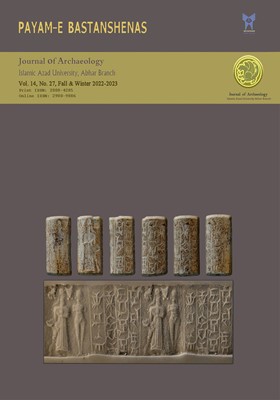Ethnoarchaeological Investigations of Tang Mansouri and Nukhan Villages in Kermanshah Province and their Importance in Archaeological Interpretations with Emphasis on Garbage Disposal Patterns
Subject Areas : Prehistoric Archaeology
1 - Ph.D. Candidate in Archaeology, Department of Archaeology, University of Tehran, Tehran, Iran.
Keywords: Ethnoarchaeology, garbage disposal, archaeological landscape, Tang Mansouri, Nukhan,
Abstract :
In the last few decades, the rapid development of technologies has caused extended and rapid changes in various aspects of human life, from architecture and social structure to clothing and food. Therefore, today there are few places and communities that have remained away from these changes. For this reason, it is very important to record the information available in such places that have preserved their traditional foundation to help in the recognition of archaeological findings and the analysis and interpretation of data. Two villages of Tang Mansouri and Nukhan in Kermanshah Province are among the few communities that have remained far away from the changes of the present age and have been able to preserve their traditional way of life to some extent. Accordingly, the two mentioned villages were considered the most suitable options for conducting ethnoarchaeological studies and hence, they were selected for this research. These two villages have been studied simultaneously and a comprehensive description of them has been presented by investigating different aspects of life. By comparing the data, suggestions are made to help archaeologists make a more accurate analysis of their findings. In addition, the pattern of waste disposal, which is very important in archaeological explorations and interpretations, has been emphasized and the landscape of the archaeological sites has been discussed.
پاپلی یزدی، لیلا (1381). بررسی سلسله مراتب جمعیتی، اجتماعی و اقتصادی در روستاهای امروزین دشت درگز خراسان با توجه به نظریه مکان مرکزی و روش قومباستان¬شناسی. پایاننامه کارشناسی ارشد، رشته باستانشناسی، دانشکده علوم انسانی، دانشگاه تربیت مدرس (منتشر نشده).
حافظنیا، محمدرضا (1392). مقدمهای بر روش تحقیق در علوم انسانی (تجدیدنظر اساسی با اضافات). تهران: سمت.
خسروی، شکوه (1388). الگوهای استقرار پیشازتاریخ حوضۀ آبریز ابهر رود، پایاننامه کارشناسی ارشد، رشته باستان¬شناسی، دانشکده علوم انسانی، دانشگاه تربیت مدرس (منتشر نشده).
رفیعفر، جلالالدین (1368). روستای هوفل. جامعهشناسی هنر و ادبیات. نامه علوم اجتماعی سابق، 1(3)، 59-35.
رفیعفر، جلالالدین (1385). مردم شناسی با تکیه بر اشیاء. نامه انسان شناسی، 1(2 و 3)، ۲۳-۳۱.
رفیعفر، جلالالدین، قربانی، حمیدرضا (1387). از کوچندگی تا یکجانشینی؛ رویکرد باستانمردمشناختی بر خاستگاه خانه و استراتژی معیشتی در دورۀ نوسنگی. نامۀ باستانشناسی، 5(9)، 84-116.
رفیعفر، جلالالدین، غربی موسی الرضا، زرقی، محمد (1394). آسیابانی و بازنمایی مناسبات اجتماعی طبقات فرودست در جوامع روستایی: بررسی پدیده ی آسیاب و آسیابانی در روستای حسن آباد ششتمد سبزوار. مطالعات و تحقیقات اجتماعی در ایران، 4(3)، 375-407.
رفیعفر، جلالالدین، میراحمدی، پورسعید (1396). کپرنشینی یا کپرزدایی؟ مطالعۀ مردم شناختی کپرنشینان شهرستان عنبرآباد (جیرفت). نشریه توسعه محلی (روستایی- شهری) توسعه روستایی سابق، 9(1)، 1-26.
رمضانی، حسن (1395). رویکرد باستانمردمشناختی بر خاستگاه یکجانشینی و تغییر در شیوه معیشتی در دوره نوسنگی با تاکید بر شمال غرب کرمانشاه، پایاننامه کارشناسی ارشد، رشته باستان¬شناسی، دانشکده هنر و معماری، دانشگاه بو علی سینا (منتشر نشده).
سازمان جغرافیایی نیروهای مسلح (1386). فرهنگ جغرافیایی آبادیهای کشور استان کردستان: شهرستانهای سقز، مریواني. تهران.
علی بیگی، سجاد، مک گینس، جان (1398). ترانشههای لایهنگاری را کجا حفر کنیم؟ یادداشتی دربارۀ ارتباط میان روند شکلگیری محوطههای باستانی، محل ترانشه و نتایج کاوشهای لایهشناختی. باستانشناسی، 3(3)، ۶۸-۴۶.
علیزاده، عباس (1383). تئوری و عمل در باستانشناسی (با فصلهایی در زیستشناسی تحولی و معرفتشناسی)، تهران: سازمان میراث فرهنگی کشور.
عمراني، قاسمعلي (1383). مواد زائد جامد. جلد اول و دوم، تهران: مركز انتشارات علمي دانشگاه آزاد اسلامي.
محمد پور، محمد (1392). از سنت به نوسازی (مطالعۀ موردی تغییرات اجتماعی به روش اتنوگرافی). تهران: جامعهشناسان.
نوری، محدث (1408 ق). مستدرک الوسائل. قم: مؤسسه آل البیت قم، 16، ج 16.
ودادهیر، ابوعلی، امیدوار، نسرین، رفیعفر، جلالالدین، جوان محبوب دوست، سارا (1395). مطالعة قومنگارانة غذاهای محلی در شهرستان فومن: پژوهشی در مردمشناسی غذا و تغذیه. مجله مطالعات اجتماعی ایران، 9(4)، ۱۰۶ -۱۳۸.
هاشم نژاد، هاشم، مولانایی، صلاحالدین (1378). معماری با نگاهی به آسمان. نشریۀ هنرهای زیبا، (36)، ۲۶-۱۷.
Derwett, P. (1999). Field Archaeology: An Introduction. UCL Press.
Godsen, C., (1999). Archaeology and Anthropology. Routledge.
Hole, F. (1979). Rediscovering the past in the present: ethnoarchaeology in Luristan, Iran. Ethnoarchaeology: Implications of ethnography for archaeology, 192-218.
Horne, L. (1994). Village spaces: settlement and society in northeastern Iran. Smithsonian Institution Press.
Kramer, C. (1979). An archaeological view of a contemporary Kurdish village: domestic architecture, household size, and wealth. Ethnoarchaeology: Implications of ethnography for archaeology, 139-163.
Shepperson, M. (2017). Sunlight and shade in the first cities: a sensory archaeology of early Iraq. Vandenhoeck & Ruprecht.
Sumner, W. M. (1979). Estimating population by analogy: an example. Ethnoarchaeology: implications of ethnography for archaeology, 164-174.
Trigger, B. (1981). Anglo‐American archaeology. World Archaeology, 13(2), 138-155.
Watson, P. J. (1966). Clues to Iranian prehistory in modern village life. Expedition, 8(3), 9. Watson, P. J., & Benco, N. L. (1979). Archaeological ethnography in western Iran. Viking Fund publications in anthropology.


